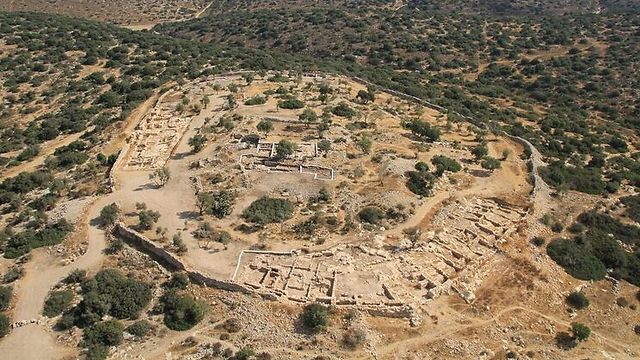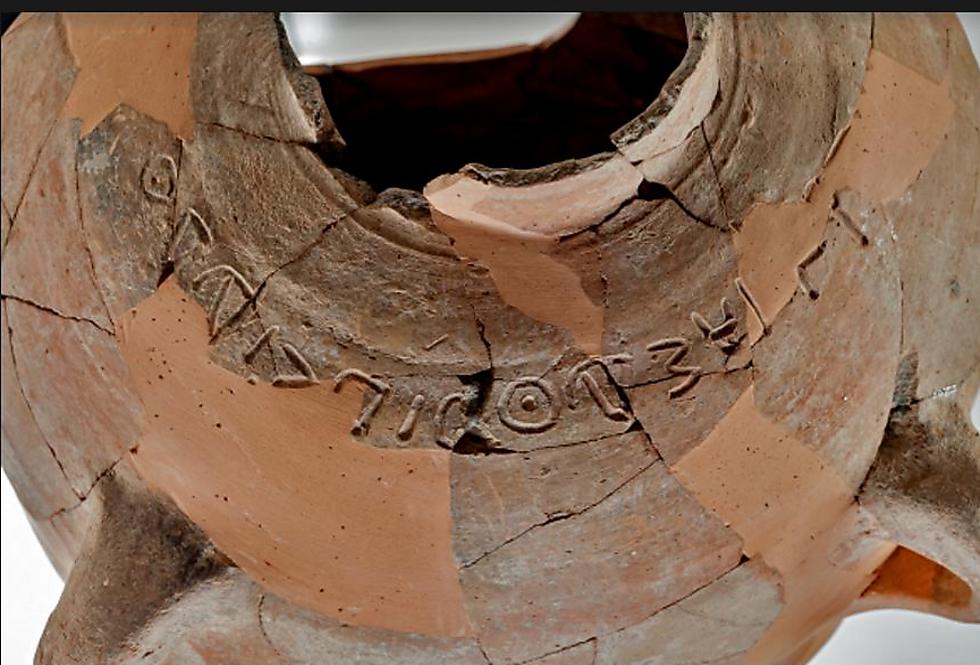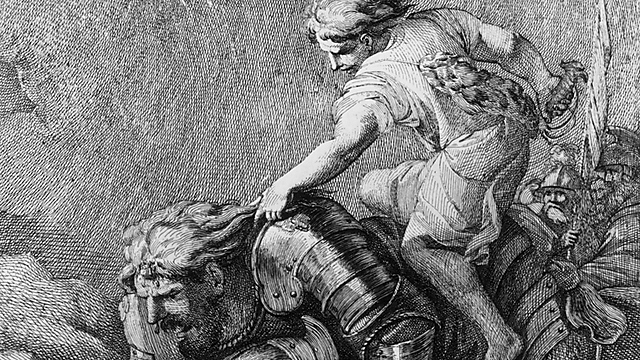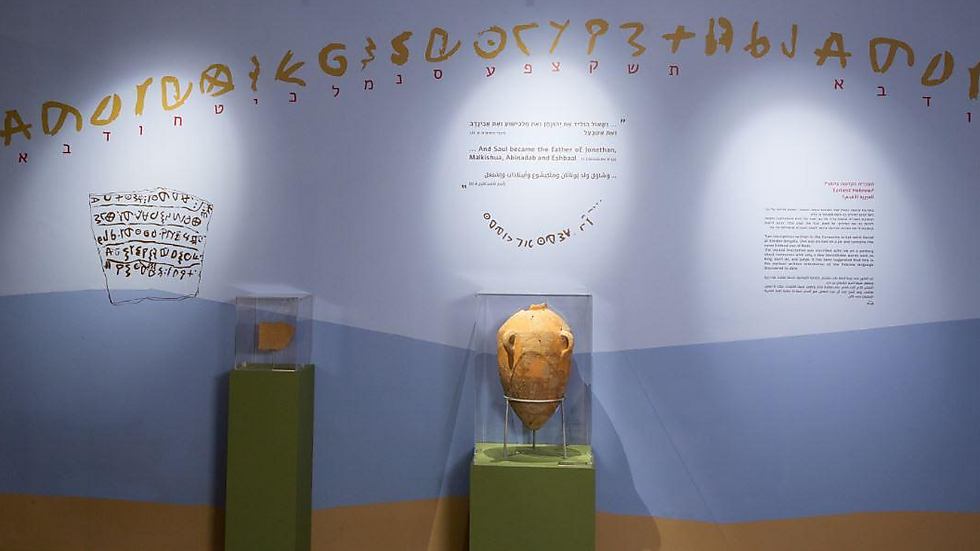
So was it David who killed Goliath?
A new exhibition at the Bible Lands Museum in Jerusalem features a series of fascinating archaeological findings which may shed light on the famous biblical battle and on the beginning of monarchy in Israel.
In 2007, archaeological excavations were launched between the coastal plain and Judea. Their findings have uncovered a series of fascinating discoveries, which may shed light on the biblical story of the battle between David and Goliath and the tumultuous period of the beginning of monarchy in Israel.
The enigmatic findings and the story behind them are now featured in a new exhibition at the Bible Lands Museum in Jerusalem, “In the Valley of David and Goliath.”

“We have a mysterious archaeological site here, with some unusual interface points with the biblical texts,” says Dr. Edith Kimchi, director of the museum’s Education Department. The mysterious site is known as Khirbet Qeiyafa and is located in Israel's Elah Valley, in the Beit Shemesh area.
What sparked the researchers’ imagination, she says, and led to the great interest in what was “just another archaeological excavation among many” began with a radiocarbon dating test conducted on olive pits found at the site. This led the researchers to the period in which the Kingdom of David was established, according to the Bible. So far, no archaeological evidence for the existence of this period has been found in Israel.
What does this have to do with the David–Goliath battle?
According to Yehuda Kaplan, one of the curators of the exhibition, the answer can be summed up in one word: location. “The date received in the radiocarbon dating test takes us back to the end of the period of judges and to the beginning of the Kingdom of Judah.

“We have a very accurate geographical indication of the valley where the Philistines gathered for a war against Israel. The Bible says it happened between Sokho and Azekah, which are both geographical locations that we have identified at a very high level of certainty. In the description of the battle itself we find, of course, a lot of mythical elements aimed at glorifying David and presenting him as fit to be king. So if there was a battle, this is the area it took place in.”
Kaplan says that Prof. Yosef Garfinkel, one of the leaders of the excavation, believes that “Qeiyafa” is in fact the biblical city of Sha’arayim, which is mentioned in the story of the battle: “Part of the description of this legendary battle notes that after seeing their hero fall and die, the Philistines fled back to Gath and Ekron (the nearby Philistine cities) through Sha’arayim.
“Surprisingly, and very uniquely for a small and fortified city, two impressive gates were found at the site. During the time of David, Jerusalem covered an area of 40-50 dunams (about 9-12 acres), and this city was half of that. So why two gates? And why one facing Philistia and the other facing the opposite direction? We have no answer, just an assumption. Sha’arayim is also mentioned as a community located on the land of the tribe of Judah in the exact same area. So far, that’s the best explanation I have encountered, linking an archaeological finding to the name. Is this indeed the Sha’arayim which witnessed that battle? Who knows.”
David or the mysterious Elhanan?
Using the Bible to explain archaeological findings is controversial. Even in the exhibition itself, the curators constantly try to offer the audience a variety of directions and assumptions about the exhibits.
“In the gap between a myth and reality backed by archeological findings, there is a lot of grey area,” says Kaplan. “Archaeology doesn’t have the ability to say if something happened or did not happen, about a lot of stuff. For example, we have not found Goliath’s skeleton or shield.
“There have also been doubts whether David himself was a real figure. Some researchers accept every line in the Bible, and others see it as a mythological collection and therefore saw David as a sort of ‘King Arthur.’ The Bible, in any event, is not a history book. It reflects opinions. It has a didactic mission, but in my eyes, it has absorbed historical material.”
Kaplan adds that “the Bible itself is uncertain about who killed Goliath (2 Samuel 21). There is a shortened tradition which asserts that he was killed by someone from Bethlehem called Elhanan. One may suggest that there was more than one Goliath, or that there was a tradition about a hero from Bethlehem who killed Goliath, and that the Bible, which made David more and more central over time, ‘copy pasted’ and attributed the story to King David. There is no way of knowing.”
According to Kaplan, an Aramaic inscription found in Tel Dan in 1993 and 1994 (which is displayed in the exhibition) finally removed King David from the “myth” category to the proven reality. “It’s a bragging inscription in which the king of Aram presents the list of kings he subdued. Alongside the king of Israel, appears a king called ‘Beit David.’ This is a rare source coming from someone from the outside who did not write the Bible, and on the other hand, acknowledges David as the founder of the royal dynasty. This is clear historical evidence. But in our story, things are more subject to interpretation in terms of the identity of the residents in the uncovered city.

“An empire, a kingdom—as the kingdom of David and Solomon is described—is a complicated mechanism which includes bureaucracy and fortified cities. Hardly any archaeological remains have been found from that period. But then they find evidence of a city with two gates; a planned, fortified city, like you find in a kingdom society. Rural people don’t build such a thing. It requires an organized, guiding mechanism. And the question is: Who issued the order?”
The excavation delegation was led by led by Prof. Yosef Garfinkel of the Institute of Archaeology at the Hebrew University of Jerusalem, Sa'ar Ganor from the Israel Antiquities Authority and Prof. Michael Hazel of the Southern Adventist University of Tennessee, who tried to claim that there was an attempt by the young Kingdom of Judah to spread and take over the important road leading from the coast to mountain ridge.
On the other hand, the findings are not unequivocal. According to the excavators, this may be evidence for the earliest Judaic settlement found, and on the other hand, it may be an ancient Canaanite city which remained.
“In any event, the site was populated for a short period of time,” says Kaplan. “You don’t see a development. And on the other hand, you do see evidence of a violent destruction. The excavators’ suggestion was to see this city as an attempt by the Kingdom of Judah to hold onto the land, an attempt which failed.
“We should remember where Goliath came from: From Gath. Gath was huge a city which was being dug for 20 years. The Philistines were, undoubtedly, a significant security threat. That is also the reason why Samuel was asked to crown them a king who might be able to remove the threat.”
The most ancient Hebrew inscription
So what was found on the site which won’t stop occupying researchers? Quite a lot, it seems. “For example, animal bones—a finding which can indicate not only the nutrition but also the ethnic affiliation. They did not find any pig bones, which are found in Philistine sites. This indicates that we are not talking about a Philistine population. On the other hand, Canaanites didn’t eat pork either.”
The excavators also found in the city two inscriptions which are the cause of a war of versions between researchers: “We found an inscription in Canaanite alphabet on broken clay pottery. On the other hand, it was much older than other findings of Canaanite writing from the same period. This is also the writing from which the ancient Hebrew writing later developed. Most of the inscription is unreadable, but the researchers managed to identify five words: king, judged and phrases such as ‘don’t do’ and ‘work,’” says Kaplan. “If it’s Hebrew, then it’s the most ancient inscription found.”
Another inscription which raises interest was found on a ceramic jar. “It’s a first name: Esh Baal Ben Bada. We don’t know Bada. It could be Canaanite. Baal sounds Canaanite because of the Baal prophets and in a Canaanite context. But Baal is not divinity; it is a name of respect for the god. When you look for ‘Esh Baal’ in the Bible, you find it in the five sons of Saul in the Book of Chronicles. The Book of Samuel calls him ‘Ish Bosheth,’ the son who ruled after Saul until he was murdered. In terms of the dates, it falls on the exact period we are discussing, of Saul, David and Samuel.

“They didn’t find a main temple in the city, but they did find evidence of ritual activity in the area of the gate, and inside certain homes as well. This corresponds with the Book of Judges and the descriptions of ritual activity which took place in houses. They also found three fragments of temple models, some adorned with two pillars in the front and two lions and ornaments on the roof, which match the Canaanite ritual. On the other hand, there is a difference both in size and in the fact that one of them is entirely carved in stone. This model does not have descriptions of a human figure or animals, but architectural ornaments only. According to a researcher of the site, they explain the architectural descriptions of Solomon’s Temple, which David began constructing.”
So did David and Goliath happen or not? And is Qeiyafa Sha’arayim or a Canaanite settlement?
“We prefer to let the audience decide for itself which explanation it accepts. It’s possible that we will find out in the future that Qeiyafa is indeed the earliest evidence of the settlement of the people of Israel, which researchers have been waiting for. The Bible, in any event, is a vivid and fascinating source – not necessarily for answers, but also for questions: Who are we and what is our history?”










